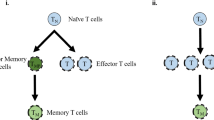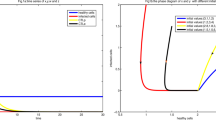Abstract
Our previous study proposed an immune network model with evolving dynamics for antigen-specificity of a lymphocyte receptor, and obtained the following results: 1) the model revealed threshold dynamics to determine an immunological self/non-self boundary, and furthermore 2) the application of the threshold dynamics enabled an immune memory function. However, as the model equations were high- dimensional and nonlinear, the study could not explicate a mechanism for these immunological phenomena by analyzing the model equations. This study proposes a “minimal and analyzable” model that enables the reproduction of these two immunological phenomena. From analyses of isoclines of the model equations, 1) the threshold dynamics stems from the so-called excitable dynamics that are well-known in the firing dynamics of the neuron, and 2) the immune memory is realized not as a stable dynamical attractor, but as a long-lasting transient. This result indicates the possibility of a new type of immune memory different from the known dynamic attractor immune memory.
Access this chapter
Tax calculation will be finalised at checkout
Purchases are for personal use only
Preview
Unable to display preview. Download preview PDF.
Similar content being viewed by others
References
Jerne, N.K.: Ann. Immunol. 125C, 373–389 (1974)
Varela, F.J., Andersson, A., Dietrich, G., Holmberg, A., Kazatchkine, D., Coutinho, A.: Proc. Natl. Acad. Sci. U. S.A. 88, 5917–5921 (1991)
Harada, K., Ikegami, T.: ECAL 1999. LNCS, vol. 1674, pp. 427–431. Springer, Heidelberg (1999)
Harada, K., Ikegami, T.: J. Theor. Biol. 203, 439–449 (2000)
Harada, K., Ikegami, T., Shiratori, N.: Proc. of Sixth International Conference on Knowledge-based Intelligent Information Engineering Systems, pp. 728–732. IOS Press, Amsterdam (2002)
Perelson, A.S. (ed.): Theoretical Immunology Parts I, II. Addison-Wesley Pub. Company Inc., New York (1988)
Hayashi, H.: Brain and Chaos. Shokabo, Tokyo (2001)
Author information
Authors and Affiliations
Editor information
Editors and Affiliations
Rights and permissions
Copyright information
© 2003 Springer-Verlag Berlin Heidelberg
About this paper
Cite this paper
Harada, K., Shiratori, N. (2003). Mechanism of a Transient but Long-Lasting Immune Memory Function on a Self/Non-Self Boundary. In: Palade, V., Howlett, R.J., Jain, L. (eds) Knowledge-Based Intelligent Information and Engineering Systems. KES 2003. Lecture Notes in Computer Science(), vol 2774. Springer, Berlin, Heidelberg. https://doi.org/10.1007/978-3-540-45226-3_71
Download citation
DOI: https://doi.org/10.1007/978-3-540-45226-3_71
Publisher Name: Springer, Berlin, Heidelberg
Print ISBN: 978-3-540-40804-8
Online ISBN: 978-3-540-45226-3
eBook Packages: Springer Book Archive




